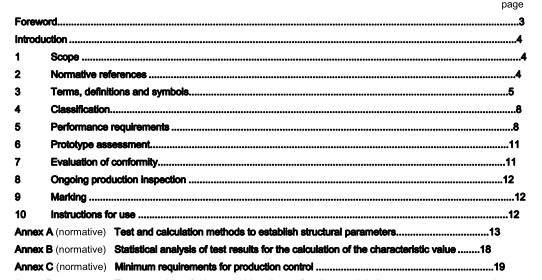BS EN 13377:2002 – Prefabricated timber formwork beams — Requirements, classification and assessment

5.3 Dimensions
5.3.1 Principal dimensions
The length of the beam shall conform to the manufacturers declared dimension within a tolerance of 10 mm.
The beam depth, H , shall conform to the data in Tables 1 and 2 within a limit deviation of ± 1 % or ± 2 mm,whichever is the smaller.
The flange width, b , shall conform to the data in Tables 1 and 2 and to the manufacturers declared dimension within a limit deviation of + 1 % and – 1,5 %.
The web thickness, t , shall conform to the manufacturers declared dimension within a limit deviation of ± 3 %.
The lattice dimensions shall conform to the manufacturers declared dimensions within a limit deviation of ± 1,5 %.
5.3.2 Dimensional movement due to moisture variation
Within the range of moisture content of 10 % to 20 %, the dimensional movement of depth H shall not exceed 1,0 % of H .
5.4 Structural properties
5.4.1 General
The characteristic resistances given in 5.4.2 and 5.4.3 are for the 5 % quantile with a 75 % confidence level.
5.4.2 Panel web beam
The values of the characteristic ultimate resistance and stiffness of a panel web beam shall be at least as great as the values given in Table 1 for the relevant class.
a) The characteristic ultimate shear resistance, V k , see column 5.
b) The characteristic ultimate bearing resistance, R b,k , see column 6.
c) The characteristic ultimate bending resistance, M k , see column 7.
d) The stiffness, E I , see column 4.
5.4.3 Lattice web beam
The values of the characteristic ultimate resistance and stiffness of a lattice beam shall be at least as great as the values given in Table 2.
a) The characteristic ultimate shear resistance, V k , see column 5.
b) The characteristic ultimate bearing resistance, R b,n,k , when supported at node points, see column 6.
c) The characteristic ultimate bearing resistance, R b,m,k , when supported between node points, see column 7.
d) The characteristic ultimate bending resistance, M n,k , when is supported at node points, see column 8.
e) The characteristic ultimate bending resistance, M m,k , when supported between node points, see column 9.
f) The stiffness, E I , see column 4.
BS EN 13377:2002 – Prefabricated timber formwork beams — Requirements, classification and assessment